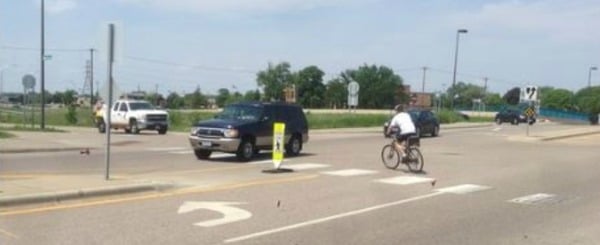
As traffic engineers, much of our work is focused on vehicle volumes and patterns. But pedestrian and bike patterns can be just important in some settings. One way to do a pedestrian/bike count is to position someone at an intersection to do a physical count. However, a faster and more cost effective way is to leverage video technology.
Recently a city engineer contacted us about a pedestrian project they were working on with the police department to increase awareness about pedestrian safety at crosswalks. The challenge they faced was accurately determining the number of pedestrians that cross the street at twenty locations in the city.
Several factors needed to be considered for this type of data collection including: the time and days of the week that data needed to be collected, and location of the counts. Also, as with most projects, cost constraints were a consideration as well.
For this project, we used a COUNTcam video capture solution from CountingCars.com. Here’s a closer look at each of the factors that impacted this project and what we considered in developing the solution.
- Resources. Doing a pedestrian/bike count manually has a number of draw backs. First there is the cost of hiring people to do the counts, and the potential risk to people who may be located next to high traffic areas. Also, pedestrian behavior often changes when they see someone sitting at an intersection in a lawn chair doing a count. We used a COUNTcam video solution for this project as the portable system is easily mounted to a pole, sign or tree so it is barely noticeable to pedestrians, and doesn’t require a person to monitor the traffic in the field. Weather is also not a factor for the video technology. The weather proof system can record up to seven days, so we can pick the best day to do the count if the weatherman is wrong with his forecast.
- Location and Time of Day. This may be one of the most important factors to consider in a pedestrian study as the surrounding areas will impact the number of pedestrians who visit an area and will drive the decision of how and when the data is best collected. For example, sidewalks near professional businesses will drive different pedestrian/bike patterns than retail shops, or community gathering places such as parks. For this project, we collected the data from 6 am to 10 pm. The COUNTcam has a long battery life so we were able to capture video before and after the designated time period in case we needed to examine additional patterns.
- Days of the Week. The location of your data collection points will also dictate the days of the week you want to collect the data. Typically, we collect data on Tuesday, Wednesday and Thursday as the other days have greater variance in traffic patterns. However, for those locations that had different pedestrian patterns, such as an area with a bar nearby, we captured video on the weekend.
- Data Analysis. Data integrity is key. Manual counts leave room for human error. However, using video technology, like the COUNTcam, provides organizations with the option of viewing and reviewing the information captured. For this particular solution, Traffic Data Inc loaded the video collected onto a computer and used the COUNTpad hardware and software system (also from CountingCars.com) to do the count. Traffic Data Inc. has done many of these types of projects and have found we can view the videos at about 20x speed which means we can view and count a 6 am to 10 pm period in less than an hour of staff time, a significant cost savings over having someone do the data collection in the field and then do additional analysis back in the office.
The result, the pedestrian/bike counts we did helped the city determine where they should place on street pedestrian crossing signs. Using this new technology allowed us to deliver the project at a fraction of the price compared to using people in the field to do a manual count. Video technology has truly changed the way we do data collection.
If you’re working on pedestrian analysis, you might also want to check out these posts:

